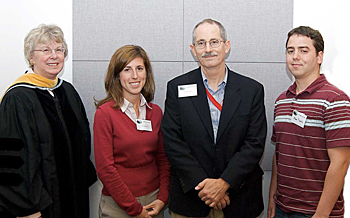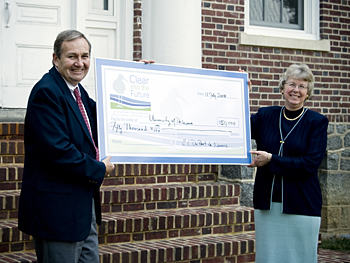
College of Marine and Earth Studies (CMES) oceanography graduate student Adam Pimenta won his fellowship after being chosen from a field of outstanding applicants from the natural and applied sciences. In addition, CMES student Kelley Appleman became the first Clear into the Future fellow to win a grant two years in a row.
“Clear into the Future is a DuPont initiative that envisions a working river and living river flowing together along one sustainable course,” said DuPont Senior Scientist Ralph G. Stahl Jr. “Adam and Kelley's scientific research will help policy makers, businesspeople and concerned members of the public find innovative ways to reconcile the Delaware Estuary's economy and ecosystem.”
“These young scientists are sustainability pioneers, and we're proud of them,” Stahl said.
CMES Dean Nancy Targett concurred and noted that, “Through their projects, these students are integrating science and policy to achieve outcomes that better serve the citizens of Delaware and the region.”
Pimenta, 24, grew up in Bristol, R.I., and earned an undergraduate degree in biology from the University of Rhode Island. He entered college as a communications major but turned to science during his sophomore year.
“I always found the marine world pretty fascinating,” Pimenta said. “I grew up near the water. I was always going to the beach and was always fishing. I think that probably had an influence on choosing marine science.”
Pimenta's research uses new technology to examine a causal chain that begins with fertilized fields, industrial runoff and flushed toilets and ends with pockets of oxygen-depleted water and dead marine life.
“Delaware Bay is a very urbanized and industrialized estuary,” he said. “Because of nutrients and carbon from land runoff, waste water treatment and other private and public inputs, you get blooms of phytoplankton.”
When the phytoplankton die, they sink to the bottom of the bay, where they are broken down by bacteria.
“When that happens, the bacteria use a lot of oxygen,” he said. “You also have chemical reactions. The biological and chemical oxygen demand creates low-oxygen conditions, and this can cause fish or shellfish kills.”
There has long been scientific interest in marine oxygen depletion, Pimenta said, but researchers typically use high-cost equipment that involves tagging with carbon isotopes. Pimenta said he plans to work with a lower cost method that features dissolved inorganic carbon and dissolved carbon-dioxide gas.

Last year, Appleman, a marine policy doctoral student, became the first recipient of a DuPont Clear into the Future Graduate Research Fellowship. This year, Appleman, 29, of Hollidaysburg, Pa., will use her $25,000 fellowship to continue studying the economic value of migratory shorebirds in the Delaware Estuary. She explained that each year hundreds of thousands of migrating shorebirds stop over in Delaware to fuel up on the eggs of spawning horseshoe crabs.
“The Delaware Estuary is the only place in the world that combines the phenomenon of shorebirds and horseshoe crabs and how the two species are intertwined,” she said. “This is a unique natural occurrence that you don't come across very often.”
In May, Appleman surveyed nearly 600 birdwatchers at three main locations in the Delaware Estuary. The surveys asked birdwatchers to answer a variety of questions, including whether or not they viewed four main migratory species, what other sites they visited, and how much they spent on their trip. To date, she has received almost 370 completed responses. Appleman expects to have preliminary results from her initial survey later this summer.
In September, she will randomly draw 1,600 Delaware residents to receive a mail questionnaire. From the responses to these questionnaires, Appleman will be able to determine nonbirders', or nonusers, intrinsic values for changes in the shorebird population.
“The information will be important for resource managers and policymakers,” Appleman said. “In order to make decisions regarding the use of the estuary's resources, it's important to understand how to allocate these scarce resources effectively.”
At some point, she hopes to repeat her research on the New Jersey side of the estuary.
DuPont awards Clear into the Future fellowships to outstanding graduate students whose research promises to add to the body of scientific knowledge about the Delaware River and Delaware Bay.
This year's six winners include two at both the University of Delaware and Rutgers University, plus one at both Delaware State and Drexel University. Each will receive a $25,000 fellowship to fund a faculty-approved research project.
For more information about DuPont's Clear into the Future initiative, go to [www.clearintothefuture.com]. For more about UD's College of Marine and Earth Studies, visit [www.ocean.udel.edu].
Article by Elizabeth Boyle
Photos by Lisa Tossey

